What is Deterministic AI: Concepts, Benefits, and Its Role in Building Reliable AI Agents (2025 Guide)
Amit Eyal Govrin

TL;DR
- Deterministic AI ensures consistency: It produces identical outputs for the same inputs crucial in DevOps pipelines (e.g., Plan & Execute Agent) and automated tax systems like TurboTax.
- It’s explainable and auditable: Every action is based on predefined rules, making systems like Oracle Health’s EHR and Conversational Agent fully transparent and traceable.
- Best for regulated workflows: In sectors like healthcare and finance, deterministic agents minimize risk by avoiding hallucinations or unpredictable outputs.
- Empowers scalable automation: Used in helpdesks (e.g., IT Support Assistant) and CI/CD workflows, these agents are production-ready and secure.
The market for AI agents has a compound annual growth rate of 46.3% from a forecast period of 2024 to 2030. It means that approximately every two years, the market value of AI agents will double in the coming years. By 2030, the market value of AI agents will reach USD 52.62 billion. Deterministic AI is poised to be at the core of this growth, as modern businesses increasingly demand AI systems that are reliable, auditable, and ready for production deployment. A deterministic AI model ensures precise, rule-based execution critical for enterprise applications like DevOps and IT automation. By delivering reliability, security, and scalability, Deterministic AI is set to accelerate the adoption of AI agents, fueling unprecedented market growth and reshaping operational efficiencies.
What Is Deterministic AI?
Deterministic AI refers to AI systems that produce the same output every time for a given input or a set of fixed inputs, eliminating randomness from decision-making. In practice, this means clearly defined, rule-based logic and controlled processes, much like a software function rather than a “black box” model. As of 2025, deterministic AI has gained renewed attention in enterprise contexts (healthcare, finance, compliance, DevOps, etc.) where precision, transparency, and reproducibility are paramount. In these domains, decision-makers demand that AI outputs be predictable, explainable, and auditable, rather than guess and hope.
From the perspective of an AI agent, determinism means operating under a strict playbook: no randomness, no surprises. Whether it’s a compliance bot validating invoices, a CI/CD agent deploying code, or a helpdesk agent routing tickets, deterministic behavior ensures that every action taken is fully traceable and testable.
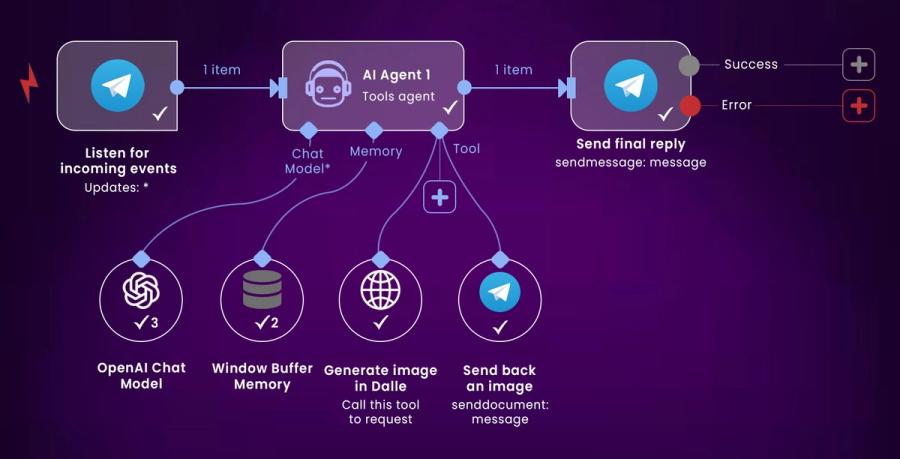
Why do we need Deterministic AI?
Modern AI workflows, especially in enterprise autonomous agents, must balance flexibility with reliability. Unlike typical LLM-based agents (e.g., Personal Productivity Assistant, like the "Smart Meeting Prep" agent) that may yield different answers on each run, deterministic agents ensure the same output when the same input or a range of the same inputs are provided. This is the only way to safely deploy agents in production environments where trust and consistency are required.
Leading AI platforms now emphasise deterministic execution with full context awareness for production readiness. As Co-Founder & CEO of Rainbird AI, James Duez, has put into words, “without a layer of deterministic reasoning, agents struggle to validate their conclusions, explain their actions, or demonstrate a causal logic chain”. Deterministic AI is the antidote to the unpredictability and hallucinations of probabilistic models, making AI agents more controllable, auditable, and reliable.
Core Benefits of Deterministic AI
Explainability & Reproducibility
Deterministic AI guarantees that an AI agent will always produce the same outcome for the same prompt or input. This makes its behavior reproducible across runs, teams, and environments. According to Stanford’s 2023 AI Index Report, more than 65% of organizations surveyed said that the biggest obstacle to adopting AI was its lack of explainability, ranking it even higher than concerns about cost or technical challenges.
Many CDSS-integrated into Electronic Health Record (EHR) systems (e.g., Epic, Oracle Health, Meditech) or standalone platforms. These often incorporate sophisticated rule engines or expert systems.
CDSSs are designed to assist healthcare professionals in making informed decisions by providing evidence-based recommendations at the point of care.
Drug-Drug Interaction Alerts:
"IF Patient_Medication_List includes 'Drug A' AND
Patient_Medication_List includes 'Drug B' AND
known_interaction_severity is 'Severe', THEN ALERT_PHYSICIAN_AND_BLOCK_PRESCRIPTION."
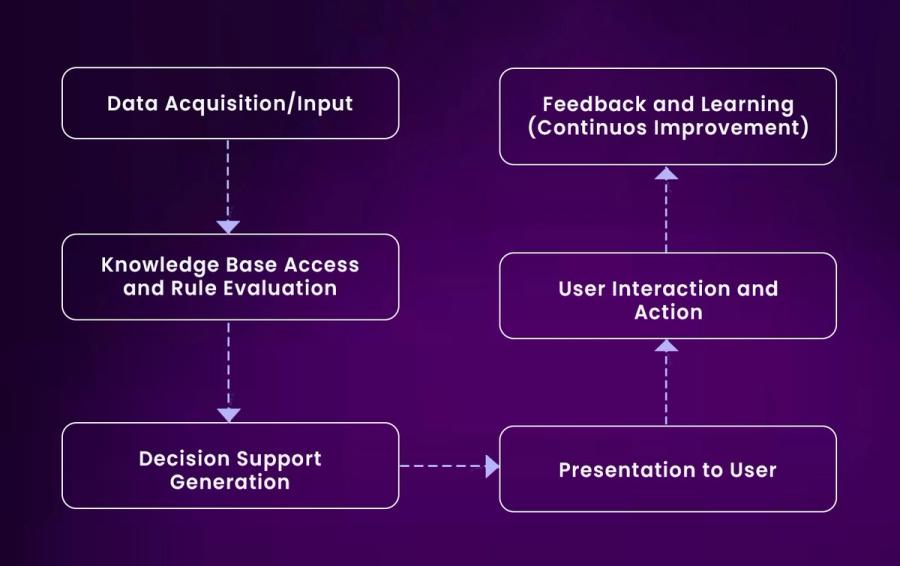
Control & Auditability
Because deterministic agents follow explicitly defined rules or knowledge models, every decision can be traced to specific logic or data. This means full transparency: companies can inspect exactly why an agent made a choice. Enterprises can build audit trails, enforce policies, and demonstrate compliance. Many banks and financial institutions use proprietary or third-party fraud detection systems built on rule-based engines or expert systems.
Examples: Companies like TurboTax, H&R Block, and professional tax software (e.g., Thomson Reuters' tax products). These are classic expert systems. They embed vast knowledge bases of tax laws, regulations (IRS code), deductions, credits, and filing requirements as explicit "if-then" rules.
The Conversational Agent, with a custom JavaScript tool workflow explicitly calls a fixed function (e.g., “return a random color”) via an AI Agent node and outputs to a structured parser. Every action in this pipeline is captured via node-level logs, making it fully traceable and inspectable.
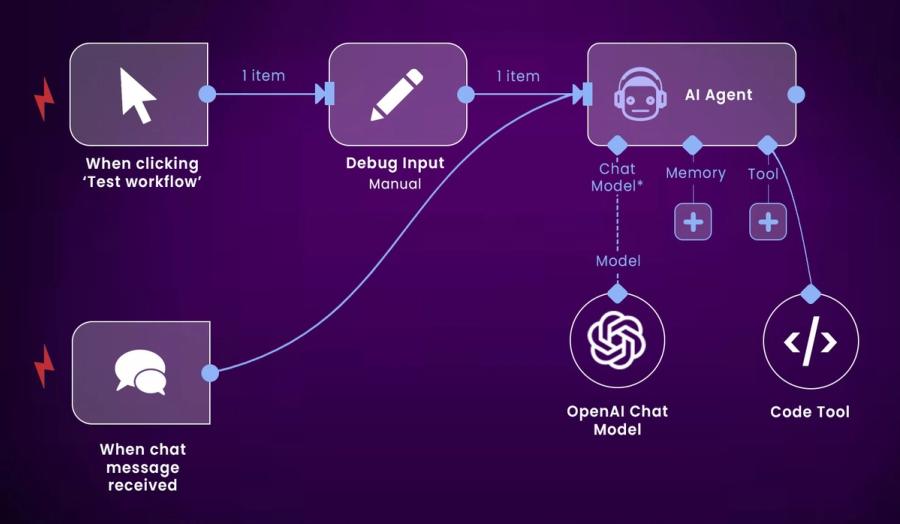
Safety & Compliance
In regulated industries, “flaky” AI is unacceptable. Deterministic AI minimizes hallucinations and unpredictable behavior, so agents won’t inadvertently violate business rules or leak information. For instance, rule-based monitoring or compliance checks run deterministically, catching issues reliably every time.
Predictable User Experience
For customer-facing tasks (chatbots, helpdesk, automated responses), consistency is key to user trust. Deterministic AI provides repeatable, high-quality interactions. Unlike probabilistic models that might give different answers to the same query, deterministic agents deliver uniform responses, which customers and regulators expect.
Example: Many e-commerce sites (e.g., Sephora, H&M for basic product info; Domino's for order placement), airlines (e.g., Singapore Airlines, for flight status), and service providers have chatbots for common queries.
Examples of Deterministic AI Systems
Here are a few characteristics of Deterministic AI
Rule-based Systems
Rule-based systems are a core component of traditional AI, designed to make decisions or solve problems using explicitly defined rules and logical conditions. A rule-based system consists of core components including rules (IF-THEN logic), a knowledge base (storing rules and facts), an inference engine (processing data to draw conclusions), working memory (holding current data), and a user interface for interaction. It operates by receiving input, matching applicable rules, executing actions, resolving conflicts if multiple rules trigger, and producing outputs like decisions or recommendations. Such systems are common in domains like diagnostics or compliance, where consistent, explainable decision-making is essential.
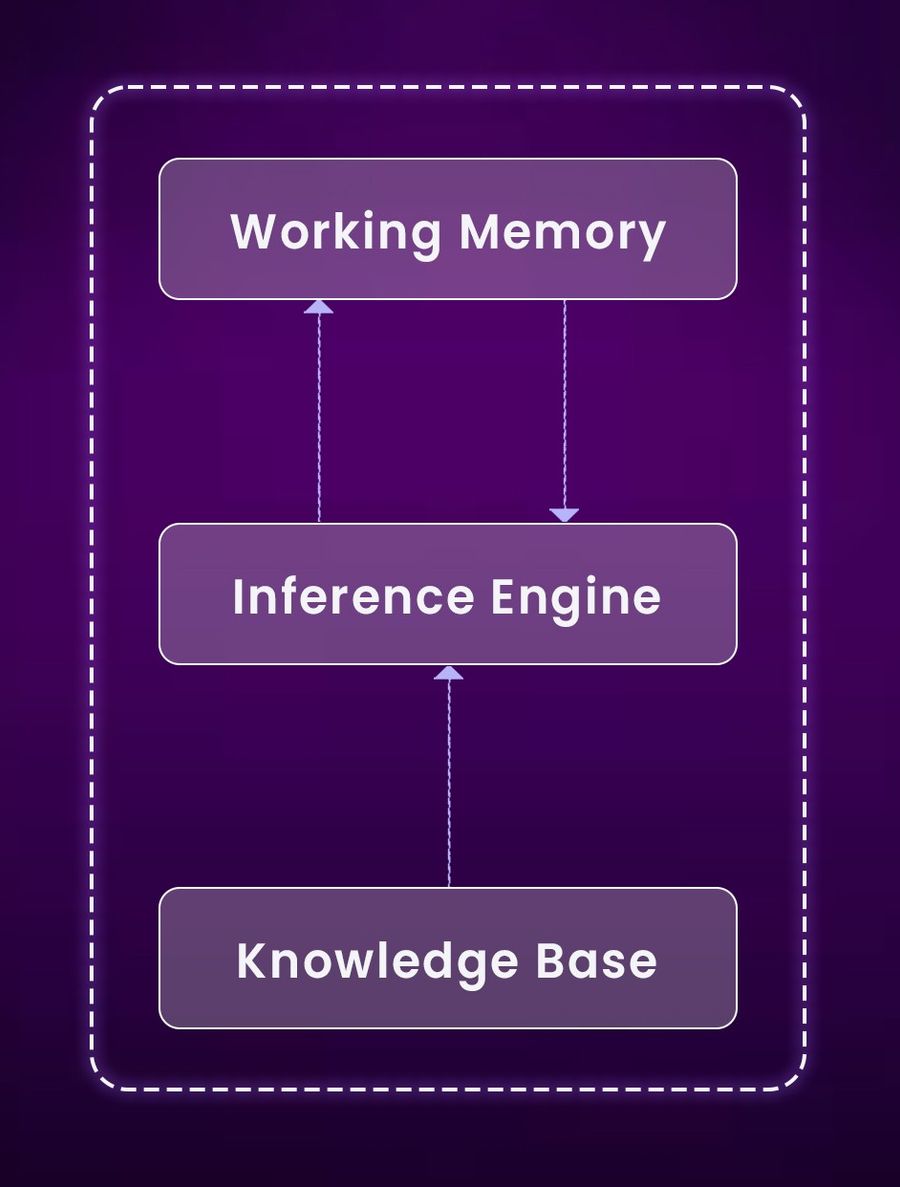
Rule-based AI agents extend this concept by autonomously enforcing logic across more complex workflows. For instance, a compliance agent can verify that supplier contracts align with company policies. Unlike basic automation tools, this AI agent can independently cross-check multiple regulations, flag inconsistencies, and request clarification.
The below code defines a RuleBasedAgent that adjusts environmental factors like temperature, humidity, and light based on sensor inputs. It uses fixed rules within a process_data method to determine actions. It demonstrates how rule-based AI agents can autonomously make decisions in response to real-time data, highlighting deterministic behavior in agentic systems.
class RuleBasedAgent:
def __init__(self):
# Define rules
self.rules = {
'temperature': self.adjust_temperature,
'humidity': self.adjust_humidity,
'light_level': self.adjust_light_level
}
def adjust_temperature(self, value):
if value > 25:
print("Temperature is too high. Turning on air conditioning.")
# Code to turn on air conditioning
elif value < 15:
print("Temperature is too low. Turning on heater.")
# Code to turn on heater
else:
print("Temperature is optimal.")
def adjust_humidity(self, value):
if value > 70:
print("Humidity is too high. Activating dehumidifier.")
# Code to activate dehumidifier
elif value < 30:
print("Humidity is too low. Activating humidifier.")
# Code to activate humidifier
else:
print("Humidity is optimal.")
def adjust_light_level(self, value):
if value < 50:
print("Low light level detected. Turning on lights.")
# Code to turn on lights
else:
print("Sufficient light level.")
def process_data(self, sensor_data):
for sensor, value in sensor_data.items():
if sensor in self.rules:
self.rules[sensor](value)
# Sample sensor data
sensor_data = {
'temperature': 28,
'humidity': 65,
'light_level': 40
}
# Create an instance of the RuleBasedAgent
agent = RuleBasedAgent()
# Process sensor data
agent.process_data(sensor_data)
Pathfinding Algorithms
Many companies use Pathfinding Algorithms (like A*, Dijkstra's, or their optimized variants) in their AI agents. For example, Google Maps, Apple Maps, Waze, HERE Technologies, TomTom, MapQuest, etc. These applications use sophisticated deterministic pathfinding algorithms (primarily Dijkstra's Algorithm and the A* search algorithm, often heavily optimized and combined with real-time data) to calculate the "best" route between two points.
Expert Systems
Deterministic AI systems, particularly Expert Systems, represent a class of AI where the output for a given input is always predictable and repeatable. There is no randomness or probabilistic element in their decision-making process. Their behavior is entirely governed by explicitly programmed rules and facts. This makes them highly transparent and auditable, as the reasoning path to any conclusion can be traced and explained.
Deterministic, expert AI systems are used in the healthcare industry, such as clinical decision support systems (CDSSs). A significant number of CDSS operate on a knowledge base composed of explicit IF-THEN rules. These rules encode clinical guidelines, best practices, drug-drug interactions, allergy alerts, diagnostic criteria, and treatment protocols. For example:
- IF (patient_age < 18) AND (drug_prescribed IS aspirin) THEN (ALERT: Aspirin is contraindicated in children due to Reye's Syndrome risk)
- IF (patient_symptoms INCLUDE fever, cough, shortness_of_breath) AND (recent_travel_history IS high_risk_area) THEN (SUGGEST: Order COVID-19 test)
Use Cases and Applications
Deterministic AI shines in enterprise workflows and DevOps automation where reliability is non-negotiable. Examples include:
DevOps and CI/CD Orchestration
AI agents that deploy applications, run tests, scan code, and configure environments must follow strict procedures. For instance, a deterministic agent can “plan workflows” to deploy a Node.js app with zero downtime, execute security scans, and set up monitoring – and it will do so identically every time. This removes the guesswork from release processes.
Example: The Plan and Execute Agent (powered by LangChain) works by first planning a sequence of tasks based on the user's objective, then executing them step by step. It's ideal for deterministic DevOps workflows, like CI/CD pipelines, because it produces a repeatable, visual plan before any execution begins. Each action (e.g., test, deploy, scan, notify) is defined as a tool or node, ensuring controlled, auditable behavior.
Internal Developer Platforms (IDPs)
Companies increasingly embed AI agents in their IDPs to assist engineers. In such settings, agents answer questions about services, run self-service actions, or automate tasks. A recent example is IDP adding a native AI “task manager” and “incident manager” to help developers know who’s on call or which pull requests need review. Because these agents operate over a well-defined data model of the organization, their reasoning stays deterministic: they retrieve exact answers from structured metadata (ownership, service status, etc.) rather than hallucinating.
Enterprise Workflows (IDPs, Helpdesks, Orchestration)
Deterministic agents can streamline cross-functional tasks within DevOps, data, or engineering teams. For instance, in DevOps, an AI-driven helpdesk agent can triage incidents by severity and route them to the correct SRE. In data teams, agents can automate schema validation, flag anomalies, or enforce access controls. Compliance bots can verify expense reports against static tax rules, or monitor financial transactions against regulatory checklists. Many ITSM platforms like ServiceNow, Zendesk, Freshservice, and specialized AI helpdesk solutions (e.g., Rezolve.ai, Moveworks) leverage deterministic agents for initial ticket handling.
Also, the IT Support Assistant Chatbot automates support ticket triage based on business rules and AI summarization. It classifies severity levels, assigns teams, logs context to Notion or CRM, and notifies through Slack—using deterministic logic nodes and schema-bound outputs.
Automated Tax Calculation System
The automated tax calculation system calculates an individual’s or company’s tax liability based on predefined rules and regulations (e.g., income brackets, deductions, tax rates). And why is it deterministic? Because it follows fixed, rule-based logic like:
IF income ≤ $50,000 THEN tax = income × 0.10
ELSE IF income ≤ $100,000 THEN tax = $5,000 + (income − $50,000) × 0.20
ELSE tax = ...
When provided with identical income, deductions, and tax regulations, it consistently generates the same tax outcome.
In 2025, Governments and financial tools like TurboTax or Zoho Books rely on deterministic systems to maintain precision, regulatory compliance, and clear audit trails. This is especially important in finance and law, where inconsistent results can cause serious legal or monetary issues.
IaC Agent for Cloud Development
Infrastructure-as-Code (IaC) for Cloud Deployment is a fundamental DevOps practice designed to automate cloud infrastructure provisioning using deterministic logic (e.g., Terraform, AWS CloudFormation) based on user instructions or policies.
When given a consistent configuration or instruction like: “Deploy a t2.micro instance in AWS with Ubuntu 22.04 and open port 22,” it generates and applies a fixed, repeatable Terraform configuration. Every time the same request is made, the exact same output is produced and deployed. It ensures repeatability, testability, and compliance.
Deterministic vs. Probabilistic AI Agents
It’s helpful to compare deterministic agents with the more familiar probabilistic (LLM-based) agents:
Reproducibility
Deterministic agents always produce the same result from the same input. Probabilistic agents (like typical GPT or other LLM agents) use randomness or learned heuristics, so their answers can vary run-to-run.
For enterprise, unpredictability is a major drawback. Non-deterministic AI tends to produce varying outcomes for the same input, making it unreliable for sensitive or customer-facing tasks.
On the other hand, deterministic agents offer consistent behavior that can be rigorously tested. By ensuring identical results for the same input across countless scenarios, they simplify debugging, support faster incident resolution, and provide greater control during system updates or changes.
Security and Compliance
Deterministic agents often run entirely within an organization’s secure infrastructure and follow strict protocols. This means sensitive data never leaves the environment, and every action can be checked against policy.
In contrast, probabilistic agents frequently rely on large public models or services, introducing data leakage risks. Moreover, unpredictability itself is a compliance risk: regulators and auditors demand that automated decisions be explainable and consistent.
Rainbird highlights that deterministic AI aligns with regulations (such as the EU’s AI Act) by providing transparent decision logic, whereas probabilistic models are often “black boxes”.
User Experience
Consistency in user interactions is greatly improved by determinism. A deterministic agent will answer the same troubleshooting question the same way every time, helping users know what to expect. Non-deterministic agents might surprise users: two identical queries could yield slightly different answers or styles. This can degrade trust and satisfaction. In mission-critical settings (customer support, SRE, etc.), agents must be rock-solid.
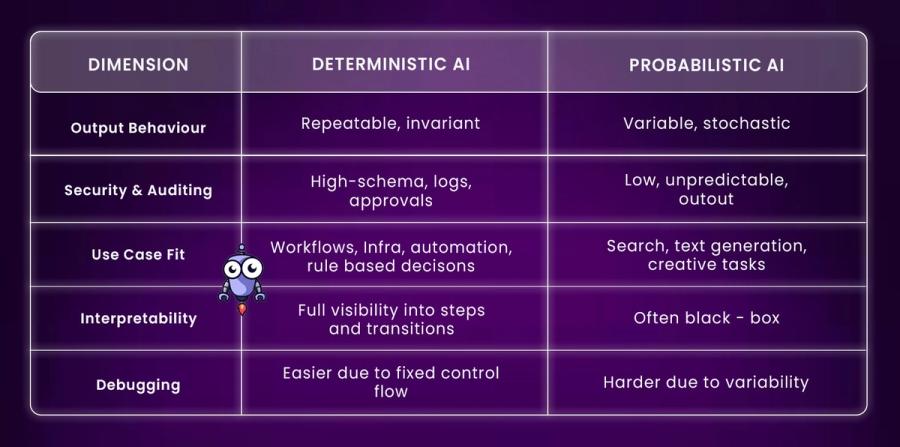
Conclusion: Why Determinism Wins in Enterprise AI
Deterministic AI is rapidly becoming the backbone of enterprise-grade AI systems. Its core strengths, predictable outputs, explainable logic, and strict compliance alignment, make it ideal for production environments in sectors like DevOps, finance, and IT support. Unlike probabilistic models that may generate variable results, deterministic agents behave consistently, ensuring safe automation and reliable decision-making. As businesses scale their use of AI, they increasingly require systems that are not just intelligent, but dependable. Deterministic AI delivers that confidence, making it the preferred choice for mission-critical workflows.
FAQs
1. What does deterministic AI mean?
Deterministic AI refers to systems where identical inputs always yield identical outputs. In other words, there is no randomness in the decision logic. A deterministic algorithm or agent will follow fixed rules or models so that its behavior is entirely reproducible. This contrasts with probabilistic AI (like standard LLMs) where answers can vary. Deterministic AI is crucial when predictability, auditability, and compliance are needed.
2. How does deterministic prompting work?
Deterministic prompting involves designing prompts and instructions that constrain an AI model’s output. Techniques include using strict templates or formats, providing schema (e.g. JSON output format), and setting sampling parameters (e.g. temperature=0) to remove variability. For example, instructing the model to output a specific JSON schema for its result means the content and structure will be consistent. In practice, many agent frameworks use function-calling: the LLM is prompted to select and fill a specific tool or function schema, resulting in highly structured (and thus deterministic) output.
3. What is an example of a deterministic environment in AI?
In deterministic environments, every action leads to a definite and predictable outcome. The agent knows precisely what will happen as a result of any action it takes.
Examples:
- Chess: Each move leads to a clear and foreseeable consequence.
- Tic-Tac-Toe: Every player’s move produces a specific, expected result.
4. What is the difference between deterministic AI and generative AI?
Deterministic AI relies on predefined rules to produce consistent, predictable outputs, making it ideal for precision-driven tasks. In contrast, Generative AI learns from data to create novel content, offering adaptability and creativity but with less predictability and potential inaccuracies. While deterministic systems excel in structure, generative models thrive in handling unstructured, dynamic data environments.
5. Is deterministic AI better than probabilistic AI?
Neither is strictly “better”; they serve different purposes.
- Deterministic AI excels when consistency, control, and compliance are top priorities (e.g. enterprise automation, regulated industries, critical infrastructure).
- Probabilistic AI (like LLMs) excels when creativity and handling ambiguity are needed (e.g. creative writing, open-ended chat, rough estimation).
In many applications, a hybrid approach is ideal: use deterministic pipelines for core tasks and probabilistic models for parts that benefit from learning or flexibility. However, for high-stakes or repetitive workflows, deterministic AI is generally preferable due to its reliability and trustworthiness.
About the author

Amit Eyal Govrin
Amit oversaw strategic DevOps partnerships at AWS as he repeatedly encountered industry leading DevOps companies struggling with similar pain-points: the Self-Service developer platforms they have created are only as effective as their end user experience. In other words, self-service is not a given.


